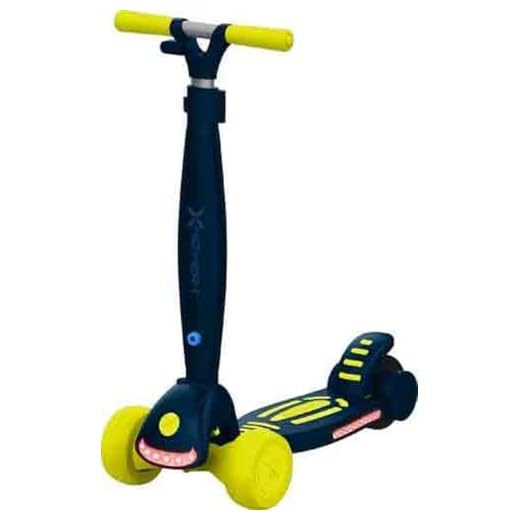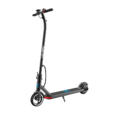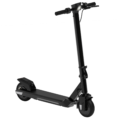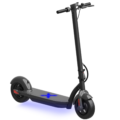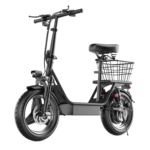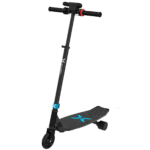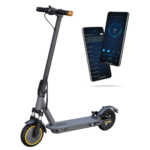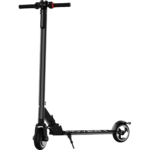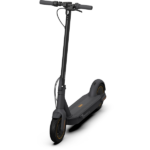- Home
- Scooters
- Electric Scooters
- Hover-1 My First E-Scooter
Hover-1 My First E-Scooter
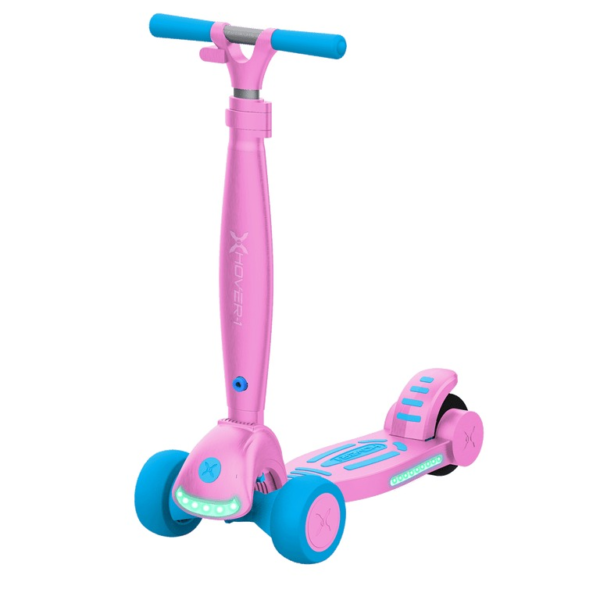

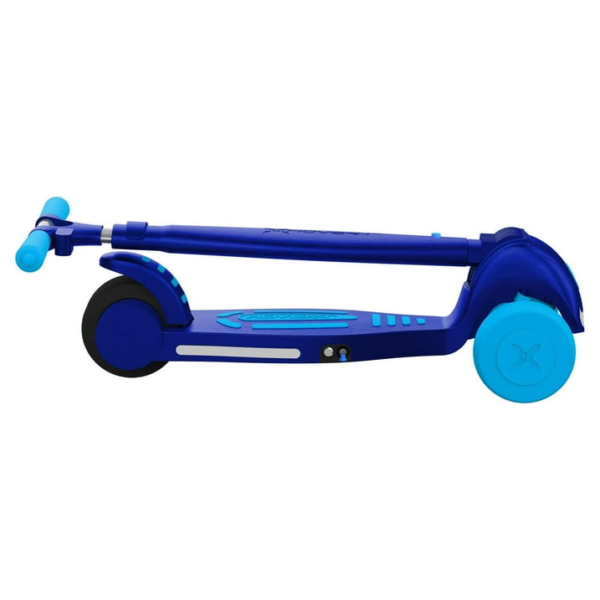

- Battery Range: 1.8 miles (3 km)
- Top Speed: 5 mph (8 km/h)
- Motor Power: 80 W
- Weight Capacity: 110 lb (50 kg)
- Charging Time: Not specified
- Scooter Weight: 10.6 lb (4.8 kg)
PROS
- 3-wheel stability
- Very light 10.6 lb
- Educational 4-in-1 learning display
- Rear brake
- Beginner-friendly 5 mph
CONS
- Very short range
- No lighting listed
- IP rating not listed
Table of contents
- What Is the Hover-1 My First E-Scooter?
- How It Works
- Key Specifications
- Design & Build Quality
- Performance Fundamentals
- Battery, Range & Efficiency
- Ride Quality & Comfort
- Braking & Safety Features
- Portability & Daily Usability
- Maintenance & Care
- Weather & Seasonal Considerations
- Hover-1 My First E-Scooter vs Alternatives
- Who the Hover-1 My First E-Scooter Is (and Isn’t) For
- FAQs
- Glossary
- Final Thoughts
The Hover-1 My First E-Scooter is a compact, three-wheel electric scooter designed to help young riders learn safely and confidently. It offers gentle acceleration, a low maximum speed, and simple controls that reduce the learning curve. Consequently, first sessions feel calm rather than chaotic. Because it’s light and folds quickly, parents will also find it easy to store and carry between rides. Moreover, its official specifications keep expectations clear: short, fun sessions on smooth, dry ground.
What Is the Hover-1 My First E-Scooter?
At its core, the Hover-1 My First E-Scooter is a beginner-friendly rideable for kids within the recommended weight range. It pairs a small 80-watt hub motor with a rechargeable lithium-ion battery and a single, press-and-hold throttle button. Additionally, the rear wheel uses a foot brake—just like a traditional kick scooter—so stopping feels familiar from the very first roll. Bright LED lighting increases visibility, while the three-wheel stance helps new riders balance at low speeds.
The design emphasizes safety and simplicity over speed. Therefore, top speed is capped, range is short on purpose, and the deck sits low for easy step-on control. Because the scooter folds, families can stash it in a closet or the trunk without a battle, which encourages frequent, short practice sessions. As a result, skills build steadily without overwhelming a new rider.
How It Works
Think of the system as a small electric helper built into a familiar scooter shape. It looks simple, yet it behaves predictably, which builds trust.
- Motor: A compact 80W hub motor sits in the wheel and provides smooth, low-noise propulsion. It’s tuned for gentle starts, so the scooter eases forward rather than lunging. Consequently, kids learn throttle control without surprises.
- Controller: An onboard controller regulates power. It meters current to the motor, limits top speed, and prevents jerky responses from small throttle changes. In practice, that means steadier tracking and fewer sudden speed spikes.
- Battery: A 14.4V, 2.0Ah lithium-ion pack stores about 28.8Wh of energy (volts × amp-hours). That’s enough for short rides around the block, practice laps on smooth paths, and quick sessions in open areas. Furthermore, the small pack charges quickly compared to larger scooters.
- Throttle: A simple press-and-hold button adds power. Kids learn to feather the button—pressing and releasing—to manage speed. Step by step, this builds confidence and situational awareness.
- Brakes: A rear fender foot brake slows the scooter by pressing the fender down onto the wheel. Because most kids already understand that motion from kick scooters, stopping becomes second nature. Even so, early practice stops are a smart habit.
In short, the scooter behaves like a kick scooter with a little electric wind at your back. Kids push off to get rolling, press the throttle to maintain movement, and step on the rear fender to slow down. Therefore, the learning curve stays gentle.
Key Specifications
Below is a clean, consolidated table of the official core data, with both metric and imperial units where applicable. These specifications frame real-world expectations for young riders.
General
- Brand / Model: Hover-1 My First E-Scooter (H1-MFSC)
- Intended Use: Beginner children within the supported weight range
- Wheel Layout: Three wheels (two up front, one rear)
Performance & Power
- Motor Power: 80W hub motor
- Top Speed: Up to 6 mph (≈ 9.7 km/h)
- Max Range: Up to 2 miles (≈ 3.2 km) under ideal conditions
Battery, Charging & Electrical
- Battery: 14.4V, 2.0Ah lithium-ion (≈ 28.8Wh)
- Charge Time: Up to 4 hours
- Operating Temp (charging/usage): 32°F to 104°F (0°C to 40°C)
- Charger: Manufacturer-supplied only (single-pin)
Build & Dimensions
- Product Weight: 10.6 lb (≈ 4.8 kg)
- Folded Size: 23.7 × 12.6 × 32.5 in (≈ 60.2 × 32.0 × 82.5 cm)
- Front Wheels: 4.5 in (≈ 114 mm) solid
- Rear Wheel: 3.5 in (≈ 89 mm) solid
- Deck: Low step-on height for easy starts
Safety & Control
- Braking: Rear foot-operated fender brake
- Lights: Front headlight and deck LEDs for visibility
- Water Resistance: Not rated; avoid water exposure
- Rider Weight Limits: Max 80 lb (≈ 36 kg); minimum supported weight 44 lb (≈ 20 kg)
Features & Extras
- Lighting Effects: Front and side/deck LEDs
- Cruise Control: Not applicable
- Fold Mechanism: Quick fold with locking hinge
Warranty & Compliance
- Warranty: 90-day limited parts and labor (manufacturer coverage)
- Usage Guidance: For flat, dry surfaces; follow local rules; store indoors
Notes: Speed, range, battery, charge time, weight limits, and folded dimensions are from official materials. Always follow the manufacturer’s operating, charging, and storage guidance.
Design & Build Quality
The Hover-1 chassis uses a molded, child-friendly shell with smooth edges and a low deck. The frame and stem are sturdy enough for repeated fold/unfold cycles, yet they remain light enough for a parent to carry with one hand. Meanwhile, the three-wheel stance widens the front track, which improves balance during the wobbly first minutes of riding.
Up front, two 4.5-inch solid wheels deliver stability while also reducing the chance of tip-induced steering. The rear 3.5-inch wheel keeps turning radius tight, so the scooter remains manageable in smaller spaces. Because all three tires are solid, there’s no risk of pinch flats or punctures. This design choice trades a bit of cushion for near-zero maintenance, which many families prefer. In other words, less time fiddling means more time riding.
The cockpit is minimal by design. A simple on/off button and a throttle button keep the control scheme uncluttered. There’s no display to distract a new rider. Soft grips help little hands stay comfortable. Fit-and-finish is appropriate for the category, with tidy panel gaps, smooth latch action on the folding hinge, and secure wiring tucked out of the way. Furthermore, LED lighting at the front and along the deck adds a dash of fun while also improving visibility for nearby pedestrians.
Finally, these specifications favor stability, predictability, and ease of use. Because the deck is low and the stem is short, the scooter feels planted. Consequently, steering inputs stay small and manageable.
Performance Fundamentals
Acceleration Feel
Acceleration is gentle. Pressing the throttle moves the scooter forward with a progressive push rather than a snap. That character builds confidence, because kids can explore throttle control without surprises. Starts are smoother if the rider first kicks off to a walking pace and then presses the button. As a result, transitions from coasting to powered cruising feel natural.
Cruising Stability
At its limited top speed, the scooter tracks predictably on smooth, flat surfaces. The wide front stance resists low-speed wobble, which is common when learners over-steer. Because the deck is low, the center of gravity stays closer to the ground, which also calms steering inputs. On uneven asphalt, riders will feel bumps more than on a larger pneumatic-tire scooter; however, the overall behavior remains controllable. If in doubt, slow down before cracks or driveway lips.
Hill-Climb Behavior (~7–10% grades)
With 80 watts on tap, climbs are modest. On gentle slopes or short ramps, the scooter slows but can continue if the rider helps with a few kicks. On sustained grades in the 7–10% range, most kids will need to step off and push. That’s expected for a first e-scooter, and it’s a worthwhile discussion to have with new riders before setting off toward a hill. Even then, downhill control remains straightforward thanks to the rear foot brake.
Battery, Range & Efficiency
The pack is small by design: 14.4V at 2.0Ah for roughly 28.8Wh. Because the scooter’s motor draws modest power and top speed is capped, energy use stays predictable. Under ideal conditions—smooth pavement, light rider within the supported range, mild temperatures, and steady cruising—the scooter can reach its rated distance of about 2 miles (≈ 3.2 km). Real-world results vary as conditions change. Consequently, plan rides with a buffer.
What affects range most?
- Rider mass: Heavier riders within the limit reduce range slightly.
- Terrain: Rough sidewalks and small inclines use more energy than smooth, flat paths.
- Speed discipline: Frequent stop-and-go riding drains the pack faster than steady cruising.
- Temperature: Cold conditions reduce battery output; warm—but not hot—days help.
Charging best practices
Charge indoors with the supplied charger only. First, let the scooter cool to room temperature after vigorous use. Next, plug in and expect up to four hours for a full charge. Avoid leaving it charging overnight, and store the scooter in a dry, ventilated area. If it will sit unused for weeks, check the charge monthly and top up briefly to keep the pack in a comfortable state. In addition, avoid deep discharges; shorter, more frequent charges are easier on small packs.
Because the battery is small, short top-ups are practical. A 20–30 minute charge can add enough energy for a quick session in the driveway or a lap around the block. That rhythm keeps young riders engaged without long waiting periods. In terms of range specifications, think “several short rides,” not “one long adventure.”
Ride Quality & Comfort
The solid tires are puncture-proof and low-maintenance, which helps new families focus on riding rather than repairs. However, solid tires do not absorb bumps like air-filled ones. As a result, the scooter rides best on smooth pavement. Small cracks or driveway lips are fine at a crawl; larger bumps should be avoided or rolled over slowly. When surfaces get rough, bend the knees slightly to act as the “suspension.” For a deeper primer on how tire construction affects comfort, grip, and upkeep as riders progress to other models, see Tires 101: tubed vs tubeless vs honeycomb and correct PSI by rider weight.
The deck’s low height aids comfort by reducing step-on effort and improving balance. Meanwhile, the three-wheel front-biased stance resists tip-overs during tight turns. There’s no suspension to tune, which actually simplifies ownership: less to adjust and fewer parts to wear. Even so, a quick wipe-down after dusty rides keeps moving parts feeling crisp.
Stem flex—the bend you sometimes feel in tall commuter scooters—is minimal here thanks to the short, stout stem. That helps steering stay consistent for small hands. For comfort, remind riders to keep both feet planted when using the throttle and to look ahead, not down at the deck. Consequently, posture improves and steering becomes smoother.
Braking & Safety Features
The rear fender brake is simple, durable, and predictable. It’s a familiar motion: step back and press down to scrub speed. Because the scooter’s top speed is modest, braking distances remain short when riders anticipate stops early. Teach kids to release the throttle before braking and to keep both hands on the grips while slowing. After a few sessions, most will blend these moves without thinking.
Lighting includes a forward headlight and deck LEDs. The beams won’t turn night into day; nevertheless, they help the scooter stand out to nearby walkers and cyclists at dusk. Reflective, bright clothing further improves visibility. There’s no official IP rating; the scooter should not be ridden in rain, through puddles, or on wet surfaces. Water exposure risks electrical issues and slippery falls. Therefore, save rides for dry days.
Finally, protective gear matters. A properly fitted helmet is essential. Elbow and knee pads add another layer of confidence during those first, wobbly sessions. Even a pair of grippy shoes helps, especially on smooth indoor floors.
Portability & Daily Usability
At about 10.6 lb (≈ 4.8 kg), the Hover-1 is easy for most adults to carry one-handed. The fold mechanism reduces the size to roughly 23.7 × 12.6 × 32.5 inches (≈ 60.2 × 32.0 × 82.5 cm). That footprint slips behind a door, into a closet, or into most car trunks. Therefore, quick trips to the park or a smooth parking lot become much simpler.
Because the scooter is compact, it’s ideal for short practice windows: five minutes before dinner, a few laps after school, or a quick weekend cruise in an open area. The light weight also makes it easy to pack for family visits, which keeps skills progressing instead of fading between rides.
A few everyday habits help:
- Power off and carry inside after every ride.
- Wipe the deck and wheels if dusty.
- Store on a flat surface away from heaters or direct sun.
- Charge before the next outing so the scooter always feels “ready.”
- Give the folding latch a quick glance to confirm a solid lock.
In addition, talk through a simple “start-stop” routine before each session: turn on, kick off, press throttle; release throttle, press fender, and step down. Repetition breeds safety.
Maintenance & Care
One goal with a first scooter is to make upkeep nearly effortless. This model largely achieves that, yet a few habits extend its life.
Quick checklist
- Before rides: Confirm the folding hinge is locked, the deck is dry, and the throttle clicks on and off.
- Weekly: Inspect wheels for embedded debris; check the brake fender for smooth action.
- Monthly: Verify all fasteners are snug—especially at the stem latch and wheel axles.
- Charging: Use only the supplied charger. Keep charge sessions indoors, away from flammable materials.
- Storage: Cool, dry, and out of direct sun. Avoid garages that freeze or bake.
- Cleaning: Lightly damp cloth only; avoid hose spray and solvents.
There are no tire pressures to check and no brake cables to tension. If a part becomes worn—such as grips or the brake fender—replace with manufacturer-approved components. Avoid DIY modifications; they can compromise safety and warranty coverage. Above all, keep water away from electrical parts.
Weather & Seasonal Considerations
Rain: Skip wet conditions entirely. With no official water-resistance rating and solid tires, rainy rides risk both traction loss and electrical problems. Therefore, wait for dry pavement.
Heat: High heat can stress batteries. After a hot ride or time in the sun, let the scooter cool indoors before charging. Never leave the charger or scooter in a parked car on a warm day. Additionally, store away from heaters.
Cold: Batteries deliver less power and range in the cold. If temperatures dip near freezing, expect shorter rides. Let the scooter warm to room temperature before charging. Because small packs sag more in the cold, stop a little earlier than usual.
Wind and debris: Because speeds are low, wind isn’t a big factor. However, fallen leaves, twigs, and sand can reduce traction. Clear the path or slow to a crawl. Likewise, watch for painted lines and metal plates after rain; they stay slick.
Season after season, the same rule applies: smooth, dry surfaces equal better control, longer range, and fewer hiccups.
Hover-1 My First E-Scooter vs Alternatives
It helps to place this scooter in context. Electric scooters fall into broad categories: beginner kids’ models, general commuter models, performance models, and off-road machines.
- Versus commuter scooters: Commuter models are heavier, faster, and built for adults. They climb better and cover longer distances; however, they introduce more speed, more mass, and more complexity than a first-time child rider needs. My First E-Scooter emphasizes control and confidence, not commute capability.
- Versus performance scooters: Performance machines are powerful and require mature skills. They aren’t appropriate for young riders. In fact, using them as a first scooter can overwhelm a child and hinder learning.
- Versus off-road scooters: Fat tires and suspension look exciting, yet they add weight and bulk. Beginners benefit more from a light, simple platform that works best on predictable surfaces.
- Versus kick scooters: A classic kick scooter is cheap, light, and always ready. However, the electric assist here helps kids practice throttle control and speed management—important stepping stones if they move up later.
In short, Hover-1’s beginner model excels when the goals are balance, basic throttle use, and short, fun rides under close supervision. Consequently, it fills a clear niche for families who want structure and safety first.
Who the Hover-1 My First E-Scooter Is (and Isn’t) For
Great for:
- Young riders within the supported 44–80 lb (≈ 20–36 kg) range
- Families who want a low-speed platform to build skills step by step
- Short practice rides on smooth, dry surfaces
- Apartments and homes where a compact, light, foldable scooter is easier to store
Not ideal for:
- Hilly neighborhoods with long grades
- Wet climates where rain rides would be common
- Riders seeking long ranges or high speeds
- Rough paths, gravel, or grass
Understanding the scooter’s purpose helps set expectations. It’s a confidence builder, not a distance runner or a hill climber. Therefore, choose it when steadiness, supervision, and simplicity matter most.
FAQs
1) How fast does it go?
Top speed is up to 6 mph (≈ 9.7 km/h) under ideal conditions. Because this model prioritizes safety, speed stays modest and predictable.
2) What’s the real-world range for kids?
Plan on short rides around the block. Under good conditions, expect up to 2 miles (≈ 3.2 km). Frequent stops, rough surfaces, colder weather, and heavier riders within the limit will shorten that distance. Consequently, start with short loops and extend as skills grow.
3) Can it ride in the rain?
No. There’s no water-resistance rating. Ride only on dry surfaces and store the scooter indoors.
4) What age is this for?
Rather than fixating on age, use the rider’s weight and coordination as guides. The supported range is roughly 44–80 lb (≈ 20–36 kg). Always supervise new riders and start in open, obstacle-free areas.
5) How long does charging take?
Up to four hours from low to full. Stick to the supplied charger and charge indoors at room temperature. Moreover, brief top-ups are fine for quick sessions.
6) Does it have cruise control or a mobile app?
No. Controls are intentionally simple: on/off, throttle button, and a rear foot brake. That simplicity helps beginners focus on balance and awareness.
7) Where can I find a “Hover-1 My First E-Scooter overview”?
You’re reading one. This guide explains how it works, who it suits, and how to get the most from it. Additionally, it summarizes the key specifications you should know before a first ride.
Glossary
- Ah (Amp-hour): A measure of how much charge a battery can store.
- Wh (Watt-hour): Battery energy (volts × amp-hours). Useful for estimating range.
- Controller: The electronics that regulate power to the motor and cap top speed.
- Hub Motor: A motor built into the wheel hub; compact and low-maintenance.
- Regen: Short for regenerative braking; not used here, but common on larger scooters.
- Deck: The platform you stand on.
- Stem: The tube connecting handlebars to the front assembly.
- Stem Flex: Bending you can feel in tall stems at speed; minimal on short beginner scooters.
- Throttle: The control that adds power; here it’s a simple push-button.
- Foot Brake: A rear fender you press down to slow or stop.
- IP Rating: Ingress Protection rating against dust/water; not provided for this model.
- UL/Compliance: Safety-testing standards for electrical products; follow maker guidance.
- Solid Tire: A rubber tire without an inner tube; puncture-proof but less cushioned.
- Pneumatic Tire: An air-filled tire; softer ride but requires pressure checks.
- Top Speed Governor: A limit set by the controller to cap maximum speed.
- Specifications: The official model details—power, battery, dimensions, and limits—that set expectations.
Final Thoughts
The Hover-1 My First E-Scooter delivers what a true beginner needs: low speed, simple controls, bright lighting, and a stable three-wheel stance. Its small battery and motor are intentional choices, because they keep rides short, speeds safe, and learning focused. With a light frame, a quick fold, and nearly zero maintenance, families can concentrate on skills and smiles instead of tools and tune-ups.
If you match expectations to purpose—short, dry, supervised sessions on smooth ground—this little scooter can be a confidence-building bridge between a kick scooter and more capable electric models down the road. Therefore, start small, practice often, and celebrate progress.
Specifications
General
| Model The Model specifies the exact version or name of the scooter. It helps identify its unique design, features, and specifications within the manufacturer’s product line. Knowing the model makes it easier to compare options, find compatible accessories, or look up support information. | My First E-Scooter |
| Brand The Brand identifies the manufacturer or company that designs and produces the scooter. A trusted brand is a sign of quality, reliability, and good customer support. Well-known brands often have higher standards for safety, performance, and after-sales service, giving you more confidence in your purchase. | Hover-1 |
| Release Date The Release Date indicates when the scooter model was officially launched on the market. This helps you know how current the design, technology, and features are. A newer release date often means updated components, improved performance, and the latest safety or smart features. | 17 November 2025 |
| Recommended Age Recommended Age indicates the minimum age range that the scooter is designed for, based on safety, size, and ease of use. Following the recommended age helps ensure that riders can handle the scooter’s speed, weight, and controls comfortably and safely. Always check local laws and use protective gear, especially for younger riders. | +4 |
Performance & Power
| Motor Power (Wattage) What it means: The motor power, measured in watts (W), shows how strong the scooter’s electric motor is. Why it matters: Higher wattage usually means better acceleration, more torque, and improved performance on hills or rough terrain. For example, a 250W motor is good for flat city roads and light riders, while a 500W or 1000W motor provides more power for faster speeds or climbing steep inclines. | 80 W rear motor |
| Top Speed The Top Speed indicates the maximum speed that the scooter can reach under optimal conditions. It’s usually measured on level ground with a fully charged battery and an average rider weight. A higher top speed allows you to travel longer distances faster, but always ensure you ride within legal speed limits and your personal comfort zone for safety. | 5 mph (8 km/h) |
| Battery Capacity Battery Capacity refers to the total amount of energy the scooter’s battery can store, usually measured in ampere-hours (Ah) or watt-hours (Wh). A higher battery capacity means you can ride longer distances on a single charge, reducing the need for frequent recharging. Keep in mind that actual range can vary depending on rider weight, terrain, speed, and weather conditions. | 14.4 V 2 Ah (28.8 Wh) |
| Estimated Range per Charge The Estimated Range per Charge indicates the average distance the scooter can travel on a single full battery charge. This range is calculated under optimal conditions, such as flat terrain, moderate speed, and average rider weight. Real-world range may vary depending on riding style, terrain, weather, and load. A longer range means fewer recharges and greater freedom for longer trips. | up to 1.8 miles (3 km) |
| Hill Climb Ability Hill Climb Ability describes the maximum incline or slope that the scooter can handle while maintaining stable performance. It’s typically expressed as a percentage or in degrees. A higher hill climb rating means the scooter can tackle steeper hills without losing too much speed or power. Actual climbing performance may vary based on rider weight, battery charge, and terrain conditions. | Not specified |
| Drive System The Drive System refers to how power from the motor is delivered to the wheels. Electric scooters typically use either a hub motor (directly integrated into the wheel) or a chain/belt drive system. A high-quality drive system ensures smooth acceleration, efficient power transfer, and low maintenance. The choice of drive system affects performance, noise level, and overall ride experience. | Not specified |
Charging & Electrical
| Charging Time Charging Time indicates how long it takes to fully recharge the scooter’s battery from empty to 100% using the standard charger provided. Faster charging means less downtime and more time on the road. Actual charging time may vary slightly depending on battery capacity, charger output, and environmental conditions. | Not specified |
| Battery Type Battery Type refers to the specific technology used in the scooter’s battery, which affects performance, lifespan, weight, and charging time. Most modern electric scooters use high-quality lithium-ion (Li-ion) batteries because they offer a good balance of energy density, durability, and low maintenance. A reliable battery type ensures consistent power delivery and longer riding ranges. | Lithium-ion pack (BMS not specified) |
| Removable Battery A Removable Battery means the battery pack can be easily detached from the scooter for convenient charging and replacement. This feature allows you to charge the battery separately, swap it with a spare for extended range, or securely store it indoors in extreme weather. Removable batteries add flexibility and make it easier to keep your scooter powered up wherever you are. | Non-removable internal battery |
| Regenerative Braking Regenerative Braking is an energy-saving feature that converts some of the energy normally lost during braking back into battery power. When you slow down or brake, the motor works in reverse to generate electricity, which helps extend the scooter’s range and improves overall efficiency. This system also reduces wear on traditional brake components, leading to lower maintenance over time. | Not specified |
| Lighting Lighting refers to the built-in front and rear lights that enhance visibility and safety when riding in low-light conditions or at night. Good lighting helps you see the road ahead and ensures that other road users can see you. Many scooters include LED headlights, taillights, and sometimes brake lights or side reflectors for added safety and compliance with local traffic regulations. | Not specified |
Build & Dimensions
| Scooter Weight Scooter Weight refers to the total weight of the scooter when fully assembled, including the battery. This affects how easy it is to carry, lift, and store the scooter when not in use. A lighter scooter is more portable and convenient for commuting, especially if you need to carry it upstairs or onto public transport. Keep in mind that a sturdy frame and quality components may add to the weight but also contribute to better durability and ride stability. | 10.6 lb (4.8 kg) |
| Maximum Rider Weight Maximum Rider Weight indicates the highest rider weight that the scooter is designed to safely support while maintaining optimal performance and stability. Staying within this limit helps ensure reliable acceleration, braking, and climbing ability, and it protects the frame, suspension, and motor from excessive strain. Exceeding the recommended limit may reduce performance and increase wear on components. | 110 lb (50 kg) |
| Deck Size Deck Size refers to the dimensions of the scooter’s standing platform. A wider and longer deck provides more foot space, allowing you to stand comfortably and adjust your stance while riding. A well-sized deck improves balance and stability, especially on longer rides or at higher speeds. Compact decks, on the other hand, help keep the scooter lightweight and portable. | 3-wheel toddler design |
| Handlebar Height Handlebar Height refers to the distance from the deck to the handlebars, which affects your riding posture and comfort. An appropriate handlebar height helps you maintain good balance, reduces strain on your back and arms, and makes steering more comfortable. Some scooters have adjustable handlebars to fit riders of different heights, while others have a fixed height for a streamlined design. | Fixed |
| Folding Mechanism The Folding Mechanism describes how easily and securely the scooter can be folded for carrying and storage. A well-designed folding system lets you quickly collapse the scooter into a compact size, making it convenient to transport on public transit, store under a desk, or fit into a car trunk. Look for sturdy latches and safety locks to ensure the scooter stays firmly in place when folded or unfolded. | Not specified |
| Dimensions Folded Dimensions indicate the size of the scooter when it’s fully folded. This measurement shows how much space the scooter will take up when stored or carried, making it easier to check if it will fit in your car trunk, under a desk, or in a closet. Compact folded dimensions are ideal for commuters who need to bring their scooter on public transport or store it in tight spaces. | Folded: 23.7 × 12.6 × 32.5 in (60.2 × 32.0 × 82.6 cm); Unfolded: Not specified |
| Material Material refers to the primary construction materials used for the scooter’s frame and key components. High-quality materials like aircraft-grade aluminum, reinforced steel, or durable composites provide strength, stability, and a lighter overall weight. A sturdy material ensures the scooter can handle daily wear and tear while maintaining safety and performance. | Plastic + metal components |
Safety & Control
| Brake Type(s) Brake Type(s) describe the braking systems the scooter uses to help you slow down or stop safely. Common brake types include mechanical brakes (like drum or disc brakes), electronic brakes, and foot brakes. Many scooters combine multiple braking systems for added safety and shorter stopping distances. The type and quality of brakes affect your control, especially when riding at higher speeds or on slopes. | Rear foot brake |
| Suspension Suspension refers to the system that absorbs shocks and vibrations while riding, providing a smoother and more comfortable ride over uneven or rough surfaces. Scooters may have front suspension, rear suspension, or dual suspension for better shock absorption and stability. Good suspension helps reduce rider fatigue and improves control, especially when riding on bumpy roads or off-road paths. | None |
| Tire Type Tire Type refers to the kind of tires the scooter uses, which directly affects ride comfort, traction, and maintenance. Common types include solid (airless) tires, pneumatic (air-filled) tires, or hybrid options. Pneumatic tires offer better shock absorption and a smoother ride on rough surfaces, while solid tires are puncture-proof and require less upkeep. The right tire type helps ensure safe handling and a comfortable ride in different conditions. | Front 4.5″ solid / Rear 3.5″ solid (3-wheel) |
| Tire Size Tire Size indicates the diameter and width of the scooter’s tires, which affect ride comfort, stability, and how well the scooter handles different terrains. Larger tires generally offer better shock absorption and a smoother ride over bumps and rough surfaces, while smaller tires keep the scooter lighter and more portable. Choosing the right tire size helps ensure a balance between agility and comfort. | 4.5-inch front / 3.5-inch rear |
| Kickstand The Kickstand is a built-in stand that allows you to park your scooter upright when it’s not in use. A sturdy kickstand keeps the scooter stable and prevents it from tipping over, protecting it from scratches and damage. It also makes storing and accessing your scooter more convenient, whether you’re at home, work, or on the go. | Not specified |
| Water Resistance Rating Water Resistance Rating indicates how well the scooter is protected against water and moisture, usually shown as an IP (Ingress Protection) rating. This rating helps you understand whether the scooter can handle light rain, splashes, or wet roads without damage. While most scooters are not fully waterproof, a good water resistance rating adds peace of mind when riding in changing weather conditions. Always avoid deep puddles or submerging the scooter to protect its electrical components. | Not specified |
Features & Extras
| Display/Console The Display (or Console) shows important real-time information about your ride, helping you monitor your scooter’s status at a glance. Typical displays show speed, battery level, distance traveled, and riding mode. Some models also include additional features like Bluetooth connectivity, app integration, or backlighting for better visibility at night. A clear and easy-to-read display enhances safety and convenience on every trip. | 4-in-1 learning display |
| Ride Modes Ride Modes refer to the different speed and power settings you can choose to match your riding style or road conditions. Common modes include eco for maximum range and energy efficiency, standard for everyday balance, and sport or turbo for higher speed and stronger acceleration. Switching between ride modes allows you to customize performance, conserve battery, and ride safely in various environments. | Not specified |
| Smart App Connectivity Smart App Connectivity lets you pair your scooter with a dedicated mobile app via Bluetooth. Using the app, you can monitor real-time ride stats like speed, battery level, and range, adjust settings such as ride modes or cruise control, lock the scooter for added security, and sometimes receive firmware updates. This feature adds convenience and allows you to personalize your riding experience right from your smartphone. | Not specified |
| Anti-Theft System The Anti-Theft System helps protect your scooter from unauthorized use or theft. This feature can include built-in alarms, electronic motor locks, GPS tracking, or remote locking through a mobile app. A good anti-theft system provides peace of mind when parking your scooter in public spaces, adding an extra layer of security to safeguard your investment. | Not specified |
| Cruise Control Cruise Control allows you to maintain a steady speed without continuously holding the throttle. This feature makes longer rides more comfortable by reducing hand fatigue and providing a smoother, more relaxed riding experience — especially on flat, open roads or bike lanes. For safety, cruise control can usually be easily activated or deactivated while riding. | No |
| Accessories Included Accessories Included lists the additional items that come with the scooter to enhance your riding experience and convenience. Common accessories may include a charger, kickstand, bell, lights, phone holder, or carrying strap. These extras add value by making your scooter safer, easier to use, and ready to ride straight out of the box. | My First E-Scooter, charger, manual |
Warranty & Compliance
| Warranty Period The Warranty Period indicates how long the manufacturer guarantees the scooter against defects in materials and workmanship under normal use. A good warranty provides peace of mind, showing the brand’s confidence in its product quality. Always check what parts are covered, such as the frame, battery, and motor, and follow the maintenance guidelines to keep your warranty valid. | Limited warranty (term not specified; region-dependent) |
| Certifications Certifications confirm that the scooter meets specific safety, quality, and environmental standards set by recognized organizations or regulatory bodies. Common certifications may include CE, RoHS, UL, or other local compliance marks, depending on your region. These certifications ensure that the scooter is manufactured to high standards and is safe and legal to use in your country. | UL 2272 battery compliance (brand standard); region-dependent |



